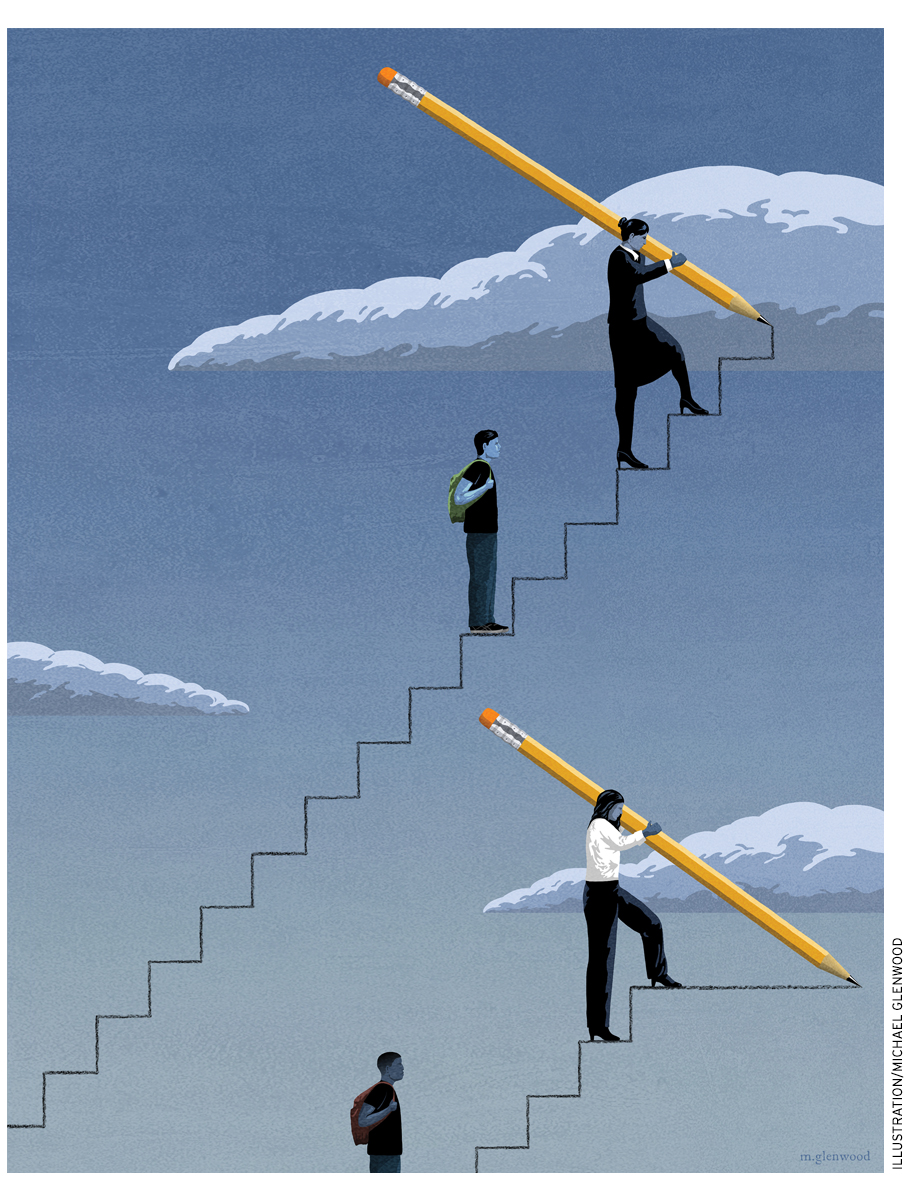 There are good reasons to assume that teachers’ beliefs and expectations can influence student success—an idea that has been embraced by parents, students, teachers, and policymakers. During graduation season each year, proud valedictorians thank the nurturing adults in their lives for pushing them to do their best. President George W. Bush famously criticized the “soft bigotry of low expectations” in support of his education-reform agenda. More recently, 2015 National Teacher of the Year Shanna Peeples declared, “You have to ignore it when a child says, ‘I don’t want to,’ because what they’re really saying is, ‘I don’t think I can and I need you to believe in me until I can believe in myself.’”
There are good reasons to assume that teachers’ beliefs and expectations can influence student success—an idea that has been embraced by parents, students, teachers, and policymakers. During graduation season each year, proud valedictorians thank the nurturing adults in their lives for pushing them to do their best. President George W. Bush famously criticized the “soft bigotry of low expectations” in support of his education-reform agenda. More recently, 2015 National Teacher of the Year Shanna Peeples declared, “You have to ignore it when a child says, ‘I don’t want to,’ because what they’re really saying is, ‘I don’t think I can and I need you to believe in me until I can believe in myself.’”
However, despite abundant anecdotes and theories suggesting a causal effect of teachers’ expectations on student outcomes, documenting its presence and size has been challenging. The reason is simple: positive correlations between what teachers expect and what students ultimately accomplish might simply result from teachers being skilled observers. In practice, distinguishing between accurate and biased expectations is difficult, because both teacher expectations and student outcomes are likely influenced by factors that researchers are unable to observe. Anecdotally, we believe that teachers’ expectations are important. But just how important might they be? And could differences in teachers’ expectations of white students and black students help to explain gaps in key outcomes such as college enrollment and completion?
To explore these questions, we analyze the federal Education Longitudinal Study of 2002, which followed a cohort of 10th-grade students for a decade. Among other questions, the students’ teachers were asked whether they expected their students to complete a four-year college degree. We use these responses to first document the presence of racial bias in teachers’ expectations, and then study the effects of differences in teacher expectations on students’ likelihood of completing college.
Our analysis supports the conventional wisdom that teacher expectations matter. College completion rates are systematically higher for students whose teachers had higher expectations for them. More troublingly, we also find that white teachers, who comprise the vast majority of American educators, have far lower expectations for black students than they do for similarly situated white students. This evidence suggests that to raise student attainment, particularly among students of color, elevating teacher expectations, eliminating racial bias, and hiring a more diverse teaching force are worthy goals.
When Expectation Becomes Reality
As a senior at her predominantly low-income Latino high school in south-central Los Angeles, Desiree Martinez told one of her teachers she dreamed of attending UCLA. In an open letter published years later, after she earned her degree, she recalled this response:
“You let out a sigh; I watched as a frown and puzzled look quickly grew on your face. You commented, ‘I don’t know why counselors push students into these schools they’re not ready for.’ My heart fell as you continued, ‘students only get their hearts broken when they don’t get into those schools and the students that do get in come back as dropouts.’”
Martinez then confided in a different teacher, who encouraged her not to let “people like that be the reason to hold you back.” Now the first in her family to graduate from college, Martinez plans to become an educator, and thanked the encouraging teacher for “pushing me when I needed it the most.” The pessimistic teacher was white; the optimistic teacher was Latino.
Teacher expectations are not always so overtly shared. In more common daily scenarios, how might they influence students’ self-perceptions and performance? Students might perceive and emotionally react to low or high teacher expectations, which could benefit or damage the quality of their work. Or, they might actively modify their own expectations and, in turn, their behavior to conform to what they believe teachers expect of them. Alternatively, teachers with expectations for certain types of students may modify how they teach, evaluate, and advise them, and in the case of low expectations, could perhaps shift their attention, time, and effort to other students.
Each of these possibilities creates feedback loops that trigger self-fulfilling prophecies: intentionally or not, teacher expectations cause student outcomes to converge on what were initially incorrect expectations.
Data
To study the extent to which these kinds of scenarios might unfold on a larger scale, we use rich survey data from the Education Longitudinal Study of 2002 (ELS), which was conducted by the U.S. Department of Education’s National Center for Education Statistics. These data are from a nationally representative sample of roughly 6,000 students from the cohort of students who were in 10th grade in 2002, and include information from student surveys, teacher surveys, standardized tests, and administrative data from schools. Most important for our purposes, teachers are asked to predict how far in school each student is likely to go, such as to finish high school, start college, or earn a degree. Our primary measure of expectations is whether a teacher expects a student to complete a four-year college degree.
Three features of the data make them well suited for an analysis of the impact of teachers’ expectations on student outcomes. First, the study followed students through 2012, providing accurate measures of educational attainment eight years removed from an on-time high-school graduation. Second, it elicited subjective expectations of each student’s ultimate educational attainment from students’ 10th-grade math and reading teachers. Having two contemporaneous expectations per student facilitates within-student comparisons of multiple teacher expectations formed at the same time. Third, the data contain rich information on students’ academic and socio-demographic backgrounds, factors that potentially affect both teacher expectations and student outcomes.
We use these data to explore two main questions. First, are teacher expectations racially biased? And second, what is the effect of teacher expectations on student outcomes?
Racial Bias in Teacher Expectations
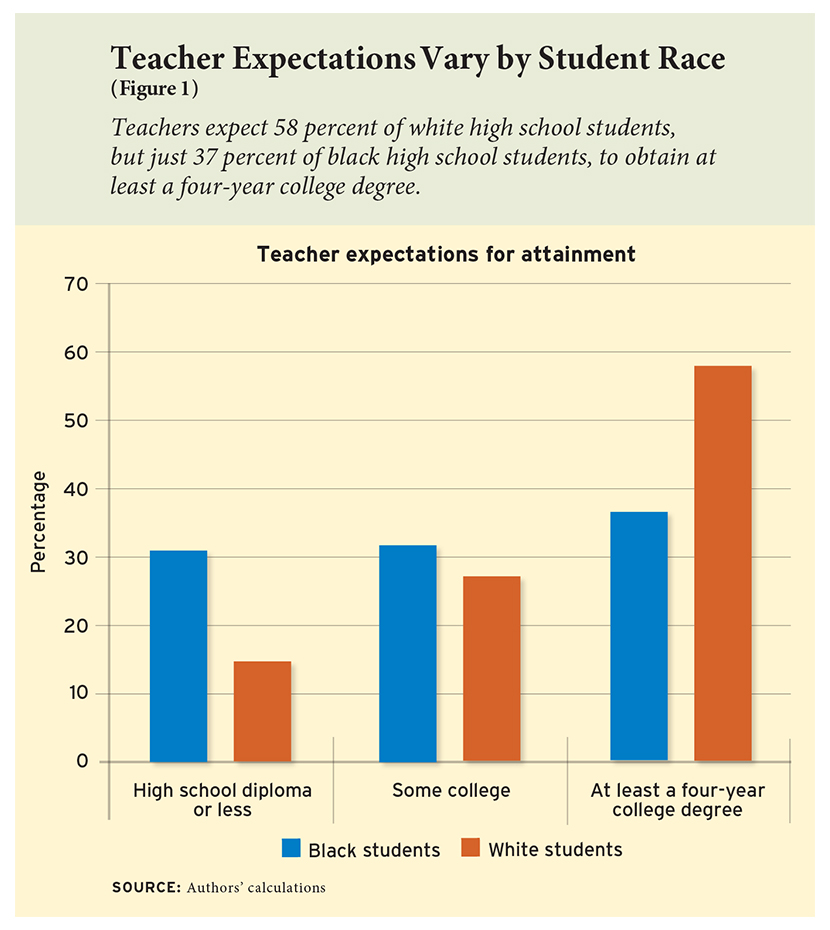 The ELS data reveal clear disparities in the expectations that teachers have for students of different races. Figure 1 shows that teachers expect 58 percent of white high-school students to obtain a four-year college degree (or more), but anticipate the same for only 37 percent of black students. This disparity foreshadows a large difference in actual educational attainment: 49 percent of white students ultimately graduate from college, compared to 29 percent of black students.
The ELS data reveal clear disparities in the expectations that teachers have for students of different races. Figure 1 shows that teachers expect 58 percent of white high-school students to obtain a four-year college degree (or more), but anticipate the same for only 37 percent of black students. This disparity foreshadows a large difference in actual educational attainment: 49 percent of white students ultimately graduate from college, compared to 29 percent of black students.
These gaps in both expectations and attainment are troubling. But it is unclear to what degree they reflect racial bias as opposed to differences in socioeconomic status and levels of academic preparation between white students and black students that could influence both expectations and outcomes. Nationwide, on average, black students are four times more likely to live below the poverty line and 30 percent less likely to have a college-educated mother than white students. Both GPA and standardized-test-score averages are lower for black students than for white students.
To what extent does the gap in teacher expectations reflect real differences in the objective probability of college completion? And to what extent is it a function of racial bias manifesting as unduly low expectations for black students relative to white students?
We look back to Martinez’s story as we exploit a unique feature of the ELS data. Recall that the survey included college-attainment predictions for each student from two of their teachers at the same school and the same time. We take advantage of the fact that if two teachers disagree about the expected educational attainment of a student, at least one of the teachers must turn out to be wrong. We further examine whether such disagreements are related to the racial match between students and teachers, which would suggest that at least a subset of teachers have systematically biased beliefs about students’ educational potential.
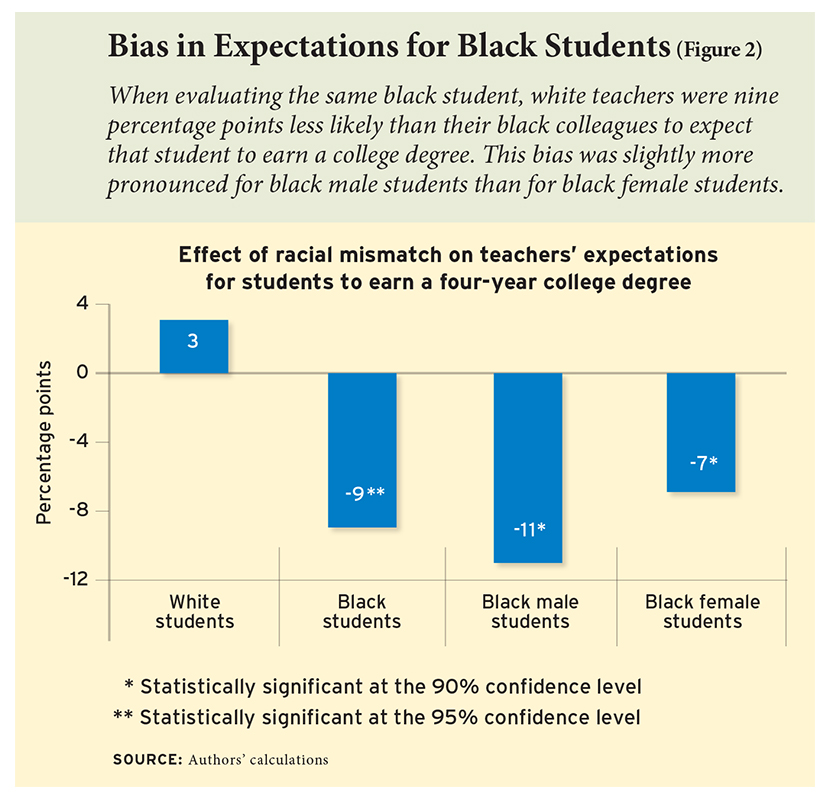 Comparing two teachers’ expectations—one black and one white—for the same student at the same point in time eliminates the effect of other aspects of the educational environment on teacher expectations and student outcomes. For example, if black students are more likely to attend and black teachers are more likely to work in under-resourced schools, a naive analysis might conflate the effect of having a same-race teacher with that of school resources. Comparing two teachers’ expectations for the same student solves this problem, because the two teachers work in the same school environment and evaluate the student at the same point in time, and thus observe the same environmental and contextual factors that might influence a student’s educational success.
Comparing two teachers’ expectations—one black and one white—for the same student at the same point in time eliminates the effect of other aspects of the educational environment on teacher expectations and student outcomes. For example, if black students are more likely to attend and black teachers are more likely to work in under-resourced schools, a naive analysis might conflate the effect of having a same-race teacher with that of school resources. Comparing two teachers’ expectations for the same student solves this problem, because the two teachers work in the same school environment and evaluate the student at the same point in time, and thus observe the same environmental and contextual factors that might influence a student’s educational success.
We find large, statistically significant bias when it comes to white teachers’ expectations for black students, and almost none for white students (see Figure 2). White teachers were 9 percentage points less likely to expect a black student to earn a college degree than their black colleagues when both teachers were evaluating the same student—on average, 33 percent of black teachers expected the student to finish college, compared to 24 percent of white teachers. We also find that these biases were slightly more pronounced for black male students than for black female students.
These results suggest ample room for biased expectations to limit black students’ educational attainment by creating self-fulfilling prophecies. However, they do not determine whether it is white teachers who are too pessimistic, black teachers who are too optimistic, or some combination of the two. Nor do they prove the existence of a causal effect of expectations on student outcomes, or shed light on the size of any such effects.
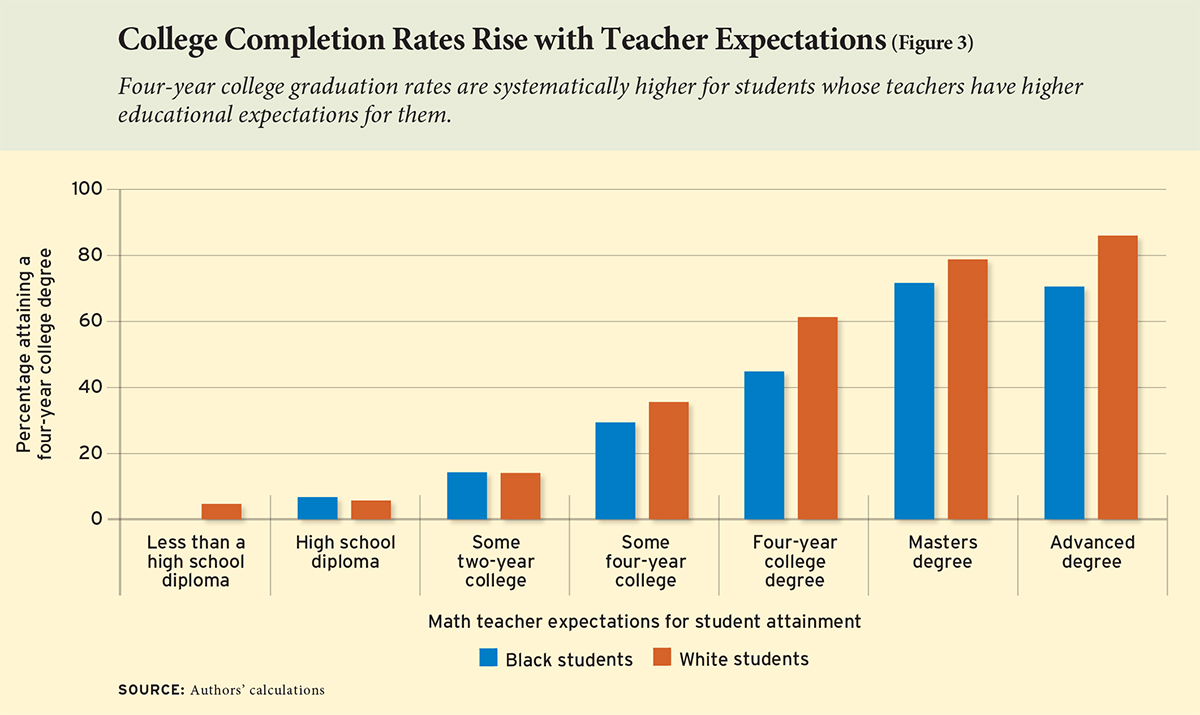
The Causal Effects of Teacher Expectations
To begin to understand the extent to which teacher expectations matter, we first compare the college completion rates of students whose teachers have lower and higher expectations for their educational attainment. Figure 3 shows that college completion rates for both white students and black students are systematically higher for students whose math teachers had higher educational expectations for them. (The same pattern is evident when using the expectations of students’ reading teachers.) However, even with the knowledge of racial biases in teacher expectations, we can’t be sure that a causal relationship between teacher expectations and student outcomes exists.
We move beyond an analysis of simple correlations by using three distinct, but related, research designs to identify the causal impact of teachers’ biases on students’ educational attainment. Each research design has different strengths and weaknesses, but the fact that they all produce similar results suggests that we have obtained good evidence on the causal effect of high-school teachers’ expectations on student outcomes.
Each of our three strategies takes advantage of the fact that multiple teachers report expectations for each student. Our first approach measures the relationship between student outcomes and one teacher’s expectation, controlling for the other teacher’s expectation as well as the student’s home background, academic ability, and past grades. The second teacher’s expectation is a valuable control in this setting, as it explicitly accounts for many of the unobserved factors that affect both the first teacher’s expectation and the student’s educational attainment. When implementing this approach, we only compare the outcomes of students for whom the same pair of teachers is making the assessments to ensure that our results are not biased by certain kinds of students being assigned to teachers with especially high (or low) expectations.
Of course, even after controlling for the second teacher’s expectation, the threat of an unobserved factor biasing our results remains. Our second approach seeks to identify random variation in teachers’ disagreements about whether students will complete college. For example, we take advantage of the fact that some teachers are more optimistic by nature than others, and thus are more likely to have high expectations for all students. We measure this in the data as the teachers’ average expectations for all students other than the one being rated.
Another possibility is that chance encounters between a teacher and a student outside the classroom might affect the teacher’s expectations for that student, whether or not the behavior was typical of the student or related to his or her likelihood of completing college. Such factors are normally unobserved by the analyst; however, the teacher survey includes a battery of teacher-specific perceptions of each student that might affect one teacher’s expectation but not another’s. Specifically, teachers were asked whether each student was “passive” and “attentive” in class. Similarly, students were asked whether they found math and reading to be “fun.” These are also factors that likely affect educational attainment, but we expect that subtle differences in the expression of these traits between 10th-grade math and English classrooms should not affect students’ educational attainment.
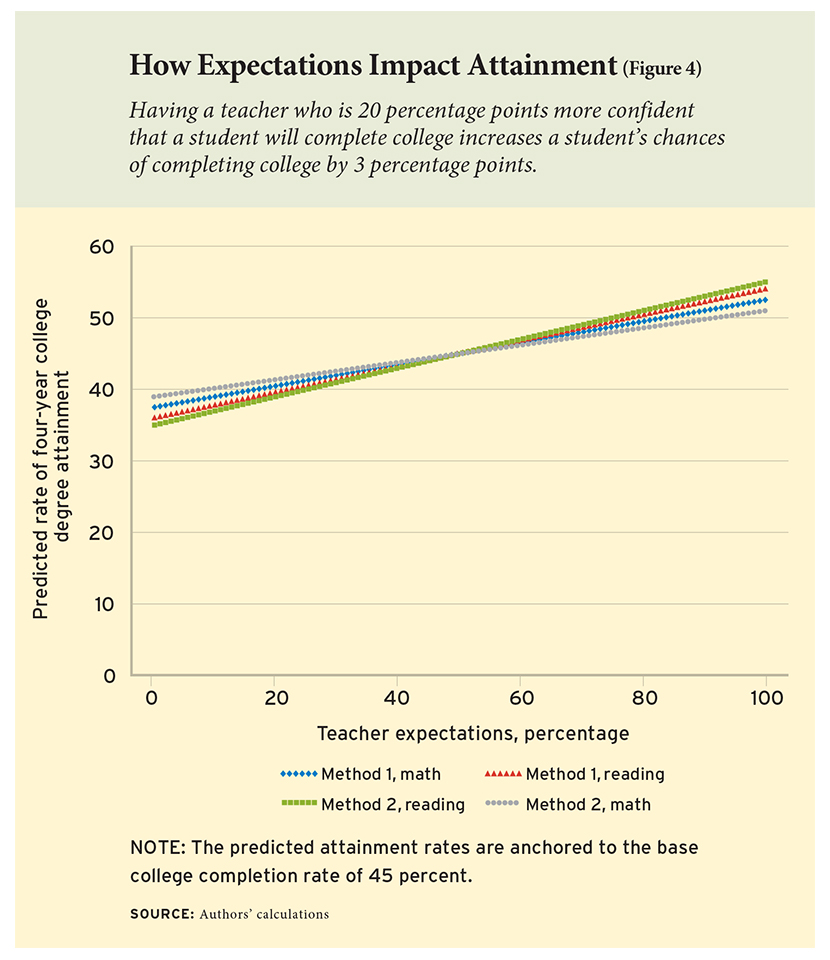 Our second research design uses each of these factors—a teacher’s optimism, her assessment of a given student’s attentiveness, and the student’s enjoyment of her class—to predict her expectations of whether the student will complete college. We then use that prediction, rather than the actual expectation captured on the survey, when estimating the effects of expectations on college completion. In doing so, our key assumption is that these factors do play a role in shaping teachers’ expectations about their students but don’t otherwise affect the student’s likelihood of completing college.
Our second research design uses each of these factors—a teacher’s optimism, her assessment of a given student’s attentiveness, and the student’s enjoyment of her class—to predict her expectations of whether the student will complete college. We then use that prediction, rather than the actual expectation captured on the survey, when estimating the effects of expectations on college completion. In doing so, our key assumption is that these factors do play a role in shaping teachers’ expectations about their students but don’t otherwise affect the student’s likelihood of completing college.
Our first two strategies produce remarkably consistent results. Having a reading teacher who expects a student to complete a four-year college degree increases the probability that the student actually goes on to complete a degree by 18–20 percentage points. The effect of a math teacher’s expectation is somewhat smaller, at 12–15 percentage points (see Figure 4). Both effects are statistically significant.
How large are these effects? To interpret these results appropriately, consider a teacher’s relative level of confidence in her student’s eventual college attainment. The difference here is not between believing a student has zero chance of completing college versus being certain that the student will earn a degree. Instead, consider what would happen if a teacher changed her confidence that a student will complete college from, say, 70 percent to 90 percent. Our estimates suggest that an increase of 20 percentage points in the likelihood that a teacher places on a student completing college leads to an increase in the eventual college attainment of about 3 percentage points, increasing the attainment rate to 48 percent from the base rate of 45 percent. This effect is similar in size to those found in evaluations of primary-school inputs’ impacts on postsecondary outcomes, such as being assigned to a teacher who is particularly effective in raising student test scores (see “Great Teaching,” research, Summer 2012).
This finding confirms that the racial gap in expectations for college attainment documented above puts black students at a disadvantage. But it does not tell us whether teacher disagreements about black students mean that black teachers are overly optimistic or white teachers are overly pessimistic.
This uncertainty motivates our third and final analytic approach, where we measure the bias in teachers’ expectations as the difference between students’ actual outcomes and whatever we would have expected based on everything we can observe about them in the absence of self-fulfilling prophecies. This approach produces two striking results.
First, we replicate our previous results on the causal impact of teacher expectations on college completion and the effects of race match on expectations. Second, our estimates of teacher biases suggests that all teachers are overly optimistic about whether their students will complete college, but that white teachers are less optimistic about black students than are black teachers. In other words, it is not generally the case that black students face negative bias from white teachers in an absolute sense. Rather, the negative bias is a relative one in that the black students do not receive the same positive bias, or benefit of the doubt, enjoyed by white students.
All teachers are optimistic, but white students receive more optimism than their black classmates. This means that even though white teachers’ lower expectations for black students are in a sense more accurate, this accuracy is selectively applied in a way that puts black students at a disadvantage. Since positive expectations increase students’ likelihood of going to college, the greater optimism heaped upon white students magnifies black-white gaps in college completion.
Implications
In sum, our analysis suggests that teacher expectations do not merely forecast student outcomes, but that they also influence outcomes by becoming self-fulfilling prophecies. Moreover, we find that the nature of white teachers’ expectations places black students at a disadvantage. For a student with a given objective probability of college completion, white teachers are less optimistic when the student in question is black. Policies that would put black students on the same footing as white students in terms of how teacher expectations are formed could narrow attainment gaps.
We identify two broad implications for education policy and practice. First, policymakers and school administrators should expand efforts to increase the diversity of the teaching force. Doing so requires both increasing the racial diversity of new entrants into the teaching pipeline (for example, via college entrance and major choice) and retaining more existing teachers of color. However, diversifying the pipeline in the short run is limited by constraints on the supply of non-white teachers, which itself is likely a consequence of the impacts of biased expectations and teacher representation discussed above.
Second, while creating a more diverse teaching force is clearly a long-term goal, there are steps schools and districts can take right away to reduce teacher bias and support positive expectations for all students. Schools can improve pre- and in-service training on expectations and bias, a potentially light-touch and low-cost intervention that can be deployed in real time. Programs that encourage empathy and cross-cultural understanding, for example, may help reduce bias-driven disparities in expectations for student outcomes.
Not surprisingly, large gaps in the objective probability of college completion exist by the time students reach the 10th grade and these would need to be addressed with earlier interventions. However, promoting positive expectations broadly among teachers of all subjects and grades can provide critical support for student success at any age.
Seth Gershenson is associate professor of public policy at the School of Public Affairs at American University. Nicholas Papageorge is Broadus Mitchell assistant professor at Krieger School of Arts and Sciences at Johns Hopkins University.
This article appeared in the Winter 2018 issue of Education Next. Suggested citation format:
Gershenson, S., and Papageorge, N. (2018). The Power of Teacher Expectations: How racial bias hinders student attainment. Education Next, 18(1), 64-70.


